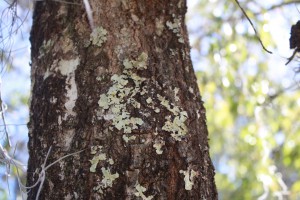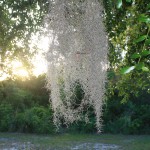Spanish moss and lichen have earned an inaccurate reputation for damaging trees and shrubs in the Florida landscape. Although they may be found in plants that are in decline or showing stress symptoms, they are simply taking advantage of space available to survive. Both plants are epiphytes and are obtaining moisture and nutrients from the atmosphere rather than from the plants they rest upon.
Lichen are more commonly found on plants that are in poor health because they need a plant that is growing slowly and access to sunlight. These conditions can typically be found in thin canopies of trees and shrubs under stress. Although they are firmly attached to the surface of the plant, they are not taking nutrients from the tree or shrub, but rather from the air and other sources such as organic debris and bird excrement. If you find lichen on your landscape plants, look further into what stress factors might be causing the plant to grow slowly such as compacted soil, extreme weather conditions, drought stress, disease or insect pressure.
Spanish moss does not harm trees and many people find it an appealing asset to their landscapes. Common misconceptions about Spanish moss include that the weight causes branches to break and that it is a host site for chiggers. Spanish moss is very light and any additional weight is typically insignificant. Although it may harbor some insects and provide nesting material for birds and other wildlife, Spanish moss in trees is not a site conducive to chiggers because they favor low-lying moist environments.
To read more about Spanish moss, lichens, and other common epiphytes please read the EDIS publication “Spanish Moss, Ball Moss, and Lichens – Harmless Epiphytes.”
- Thinking of Starting a Cut Flower Business? Don’t miss out on Cut Flower 101! - October 30, 2025
- 2025 Gardening in the Panhandle LIVE! Great Southeast Pollinator Census – Bee a Citizen Scientist! Wrap Up - September 18, 2025
- Will you Bee a Citizen Scientist? - August 15, 2025


